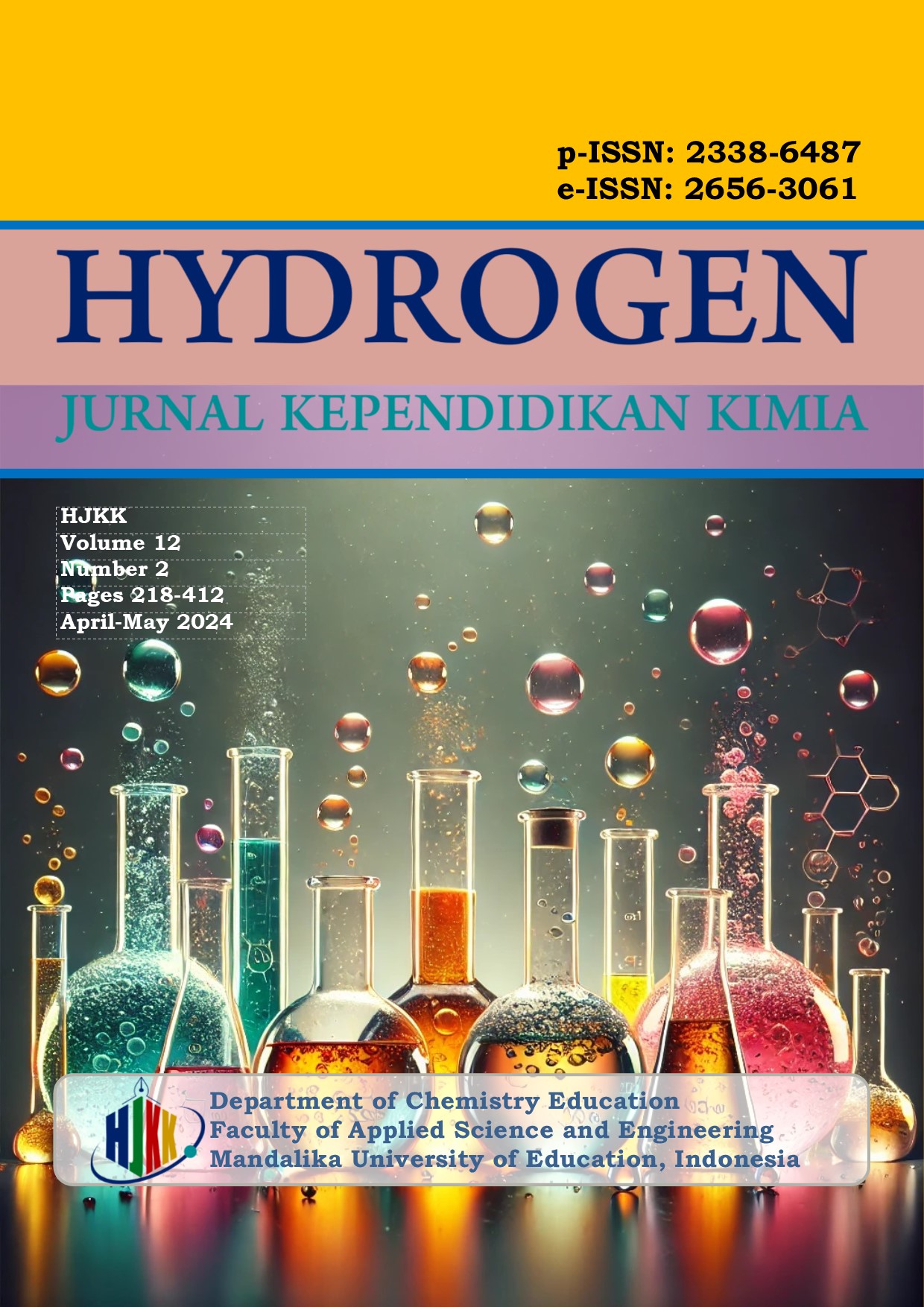Development of an Interactive Multimedia Based E-modul on Geometric Isomer Material
DOI:
https://doi.org/10.33394/hjkk.v12i2.11171Abstract
References
Abraham., M., Varghese, V., Tang, H. (2010). Using Molecular Representations To Aid Student Understanding Of Stereochemical Concepts. Journal Of Chemical Education, 87(12). 1425 – 1429.
Akbar, Sa'dun. (2013). Instrumen Perangkat Pembelajaran. Bandung: Remaja Rosdakarya.
Amirullah, G. and Susilo, S. (2018) ‘Pengembangan Media Pembelajaran Interaktif Pada Konsep Monera Berbasis Smartphone Android’, WACANA AKADEMIKA: Majalah Ilmiah Kependidikan, 2(1).
Asmar, A., & Suryadarma, I. G. P. (2021). Pengembangan Perangkat Pembelajaran Ipa Terpadu Model Nested Berbasis Perahu Phinisi Untuk Meningkatkan Keterampilan Komunikasi Dan Pengetahuan Konseptual. Jurnal Pendidikan Sains Indonesia, 9(4), 565–578.
Ayuningtyas, R. and Budiyono (2016). Analisis Kualitas Buku Siswa Kurikulum 2013 Kelas VII Sekolah Menengah Pertama. Indonesian Journal of Curriculum and Educational Technology Studies , 4(1), pp. 17–24.
Basori, M. (2016). Pengembangan Multimedia Interaktif Untuk Mata Pelajaran Ilmu Pengetahuan Sosial (Ips) Sekolah Dasar Kelas V. Jpdn: Jurnal Pendidikan Dasar Nusantara, 1(2), 75–87.
Direktorat Pembinaan SMA. (2017). Materi Workshop Pengelolaan SMA Rujukan. Jakarta: Direktorat Pembinaan Sekolah Menengah Atas, Direktorat Jenderal Pendidikan Dasar dan Menengah, Kementerian Pendidikan dan Kebudayaan.
Durmaz, M. (2018). Determination Of Prospective Chemistry Teacher’s Cognitive Structures And Misconceptions About Stereochemistry. Journal Of Education And Training Studies, 6(9).
Hurrahman, M., Erlina, E., Melati, H. A., Enawaty, E., & Sartika, R. P. (2022). Pengembangan E-Modul Berbasis Multipel Representasi Dengan Bantuan Teknologi Augmented Reality Untuk Pembelajaran Materi Bentuk Molekul. Jurnal Pendidikan Sains Indonesia, 10(1), 89–114.
Imbar, K., Ariani, D., Widyaningrum, R., & Syahyani, R. (2021). Ragam Storyboard Untuk Produksi Media Pembelajaran. Jurnal Pembelajaran Inovatif, 04(01), 108–120.
Kantun, S. and Budiawati, Y.S.R. (2015) ‘Analisis Tingkat Kelayakan Bahan Ajar Ekonomi yang Digunakan Oleh Guru di SMA Negeri 4 Jember’, Jurnal Pendidikan Ekonomi, 9(2), pp. 129–146.
Lawshe, C.H. (1975). ‘a Quantitative Approach To Content Validity’, Personnel Psychology, 28(4).
Lestari, A., Hairida, & Lestari, I. (2021). Pengembangan Lembar Kerja Peserta Didik (LKPD) Berbasis Discovery Learning Pada Materi Asam Dan Basa. Jurnal Zarah, 9(2), 117–124.
Lestari, Ira. & Erlina, E. (2020). Analisis Kebutuhan Untuk Pengembangan Sumber Dan Media Pembelajaran Kimia Di Perguruan Tinggi. Laporan Penelitian. FKIP Universitas Tanjungpura. DIPA 2021.
Lestari, Ira. & Erlina, E. (2021). Identifikasi Pemahaman Mahasiswa Pendidikan Kimia pada Materi Stereokimia Hidrokarbon. Edukatif: Jurnal Ilmu Pendidikan, Vol. 3, No. 6 : 4810 – 4817.
Lyon, G. (1999). College Students’ Understanding Of Stereochemistry: Difficulties In Learning And Critical Junctures. LSU Historical Dissertations And Theses.
Masrifah, S., Musdansi, D.P. and Ningsih, J.R. (2020). Pengembangan Media Pembelajaran Booklet Pada Materi Sistem Koloid Untuk Kelas XI IPA SMA NEGERI BINAI. Jurnal Online Mahasiswa Fakultas Tarbiyah dan Keguruan Universitas Islam Kuantan Singingi, 2(20), pp. 159–166.
Nalarita, Y., & Listiawan, T. (2018). Pengembangan E-Modul Kontekstual Interaktif Berbasis Web Pada Mata Pelajaran Kimia Senyawa Hidrokarbon. Multitek Indonesia: Jurnal Ilmiah, 12(2), 85–94.
Nengsih, N.R., Yusmaita, E. and Gazali, F. (2019) ‘Evaluasi Validitas Konten dan Konstruk Bahan Ajar Asam Basa Berbasis REACT’, EduKimia, 1(1), pp. 1–10.
Prastika, N., & K. Anom W, E. (2018). Pengembangan Modul Pembelajaran Kimia Budidaya Ikan Patin Dengan Pakan Ampas Kelapa Terintegrasi Stem-Pbl Mata Kuliah Kewirausahaan. Jurnal Penelitian
Pendidikan Kimia: Kajian Hasil Penelitian Pendidikan Kimia, 5(2015), 57–67.
Pribadi, Benny. (2009). Model Desain Sistem Pembelajaran. Jakarta: Dian Rakyat.
Purwanto, Ngalim. (2012). Prinsip-prinsip dan Teknik Evaluasi Pengajaran. Bandung: PT Remaja Rosdakarya.
Puspita, A., Kurniawan, A.D. and Rahayu, H.M. (2017). Pengembangan Media Pembelajaran Booklet Pada Materi Sistem Imun Terhadap Hasil Belajar Siswa Kelas Xi Sman 8 Pontianak. Jurnal Bioeducation, 4(1), pp. 64–73.
Rico, A. E., & Fitriza, Z. (2021). Deskripsi Miskonsepsi Siswa Pada Materi Senyawa Hidrokarbon : Studi Literatur. Edukatif : Jurnal Ilmu Pendidikan, 3(4), 1495–1502.
Suarsana dan Mahayukti. (2013). Pengembangan E-modul Berorientasi Pemecahan Masalah untuk Meningkatkan Keterampilan Berpikir Kritis Mahasiswa. Jurnal Nasional Pendidikan Teknik Informatika (JANAPATI), 2(2).
Downloads
Published
How to Cite
Issue
Section
Citation Check
License
License and Publishing Agreement
In submitting the manuscript to the journal, the authors certify that:
- They are authorized by their co-authors to enter into these arrangements.
- The work described has not been formally published before, except in the form of an abstract or as part of a published lecture, review, thesis, or overlay journal.
- That it is not under consideration for publication elsewhere,
- That its publication has been approved by all the author(s) and by the responsible authorities – tacitly or explicitly – of the institutes where the work has been carried out.
- They secure the right to reproduce any material that has already been published or copyrighted elsewhere.
- They agree to the following license and publishing agreement.
Copyright
Authors who publish with Hydrogen: Jurnal Kependidikan Kimia agree to the following terms:
- Authors retain copyright and grant the journal right of first publication with the work simultaneously licensed under a Creative Commons Attribution License (CC BY-SA 4.0) that allows others to share the work with an acknowledgment of the work's authorship and initial publication in this journal.Â
- Authors are able to enter into separate, additional contractual arrangements for the non-exclusive distribution of the journal's published version of the work (e.g., post it to an institutional repository or publish it in a book), with an acknowledgment of its initial publication in this journal.
- Authors are permitted and encouraged to post their work online (e.g., in institutional repositories or on their website) prior to and during the submission process, as it can lead to productive exchanges, as well as earlier and greater citation of published work.
Licensing for Data Publication
Hydrogen: Jurnal Kependidikan Kimia uses a variety of waivers and licenses, that are specifically designed for and appropriate for the treatment of data: Open Data Commons Attribution License, http://www.opendatacommons.org/licenses/by/1.0/ (default) Other data publishing licenses may be allowed as exceptions (subject to approval by the editor on a case-by-case basis) and should be justified with a written statement from the author, which will be published with the article.







